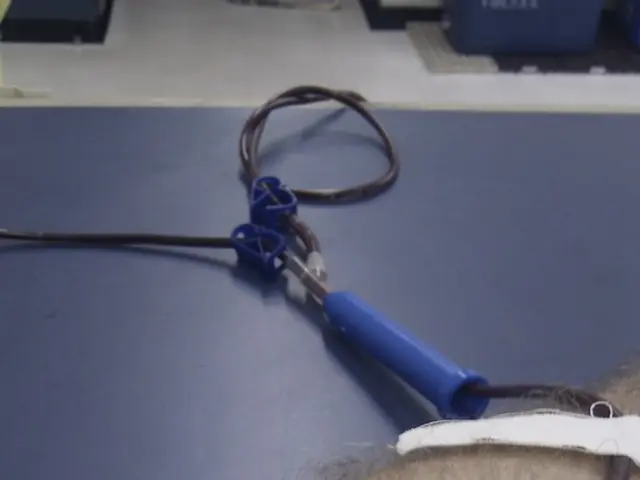Walking Aids: Understanding the Appropriate Use of Walkers and Canes
Assistive Devices for Mobility Support: Choosing Between Canes and Walkers
As individuals age, chronic conditions such as joint pain and respiratory issues may impact balance and mobility. According to the Centers for Disease Control and Prevention (CDC), these challenges can lead to an increased risk of falls, particularly for older adults.
In such instances, mobility-supporting devices such as canes and walkers can play a crucial role in maintaining independence and reducing the likelihood of falls. Factors like the extent of support required, one's lifestyle, and the associated costs help determine the choice between these two common devices.
| Device | Advantages | Disadvantages | Suitable Conditions | Cost || -------------- | --------- | ------------- | ------------------ | ---- || 1-Legged Cane | Balance | Minimal | Mild balance issues | $10 - $40 || 3-4 Legged Cane | Balance | Heavier | Muscle weakness | $15 - $40 || Standard Walker | Stability | Lifting | Nerve or muscular | $20 - $60 || Wheeled Walker | Mobility | Less Stable | Heart or lung issues | $35 - $100 |
Using a Canes for Mobility Assistance
Canes can assist individuals with minor balance or stability concerns, leg or trunk weakness, or injuries or pain from conditions like arthritis. Generally, a person holds a cane with one hand, and depending on its design, it may have one to four legs, with multiple legs providing enhanced stability. Adding ice grippers can also help when navigating slippery surfaces.
-helps with balance-adjustable
Individuals who have undergone total knee or hip replacement surgery or those experiencing more significant balance and mobility impairments may prefer to use a walker. These devices usually consist of three to four legs and require two-handed usage. Optional wrist or arm supports, as well as additional accessories such as wheels or brakes, can be added for greater comfort.
-for minimal weight bearing only-some have a curved handle that some may find difficult to grasp and cause pain, especially for people with joint or muscle conditions
Different Types of Canes and Walkers
-mild balance issues-mild to moderate arthritis of the lower limbs
Standard canes are typically made of wood or aluminum, featuring a rubber tip and either a hook-shaped or flat handle. They best suit those requiring minimal assistance, but those needing greater support may find multi-legged canes more suitable.
$10-$40
Multi-legged canes come in various forms, such as three- or four-legged canes that stand independently, offering more stability for those experiencing pain on one side. Some of these canes, known as "sit-to-stand" canes, also include a secondary grip, aiding in the processes of getting up and sitting down.
Walkers are categorized into three types:
-offers greater help with balance than a standard cane-can bear more weight-adjustable
- Standard walkers provide excellent stability through their four rubber-tipped legs, albeit requiring the user to lift them with each step.
- Two-wheeled walkers are more manageable due to their front wheels and backsliders, yet offer less stability and demand more cognitive effort.
- Four-wheeled walkers, also known as rollator walkers, enable users to maintain a more natural gait and often feature additional features such as brakes, a seat, and a basket, although coordination and maneuverability can be challenging due to their heavier weight.
-heavier-more cumbersome-may be harder to use on stairs
Deciding Between a Walker or a Cane
-one-sided muscle weakness (hemiparesis) or more significant issues with balance
Effective cane use necessitates an individual possessing sufficient strength to walk consistently and securely while maintaining balance, as they must be able to steady themselves if they begin to slip and coordinate the cane with their arm while walking.
$15-$40
Walkers are more appropriate for individuals with more significant balance impairments, as they allow users to shift some or all of their body weight away from their lower body while moving, providing additional support. As a person's strength and endurance improves, they can gradually begin to place more weight on their legs.
Whether using a walker with or without wheels depends on the specific needs and preferences of the individual and the environment they need to navigate.
-stable-foldable
When to Switch from a Walker to a Cane
-no wheels-needs lifting with each step
Determining whether it's time to transition from a walker to a cane or vice versa involves several factors:
-for conditions that affect the function of muscles or nerves or for fractures
- Evaluating whether balance or mobility has improved or worsened.
- Assessing changes in endurance and strength.
- Seeking advice from a healthcare professional.
- Considering daily routine requirements.
$20-$60
Where to Find Canes and Walkers
Individuals may purchase assistive devices directly from a supplier or obtain them from clinics, hospitals, insurance companies, or non-profit organizations for older adults or those with disabilities.
-easier to move-may have a seat and basket for comfort
Cost Considerations
-less stable than standard-not foldable
Canes generally cost between $10 and $40, while walkers range from $20 to $100. Many of these devices are considered Durable Medical Equipment (DME) by Medicare, making them eligible for coverage if they are medically necessary and used at home.
-issues affecting the spinal cord, conditions that slow down mobility like heart or lung diseases
Ensure Safe Use of Canes and Walkers
$35-$100
Whichever mobility device is chosen, safety should always be prioritized. Canes and walkers should be adjusted so that the handle sits at wrist level, with arms relaxed and slightly bent during use. Poor posture, such as leaning forward, should be avoided.

Cane safety precautions include holding the cane with the opposite hand of the injured or painful side when standing and following a specific pattern for ascent and descent on stairs.
Walker safety recommendations include placing the device one step ahead, moving the injured or painful leg to the middle, and then bringing the stronger leg to meet it, taking small, slow steps.
In summary, assistive devices like canes and walkers can help combat the challenges presented by chronic conditions that affect mobility in older adults. By choosing the appropriate device tailored to individual needs, lifestyle, and budget, mobility can be maintained, falls can be avoided, and independence can be preserved.
- In the aging process, chronic diseases like arthritis and respiratory issues may lead to mobility and balance issues, increasing fall risks for seniors.
- For individuals with minor balance problems or mild muscle weakness, canes offer help, and they can be adjusted to suit personal needs.
- However, for those with more significant balance issues or needing to bear more weight, walkers might be more suitable, offering increased stability.
- Science and medicine have introduced various types of canes and walkers, including standard, multi-legged, and wheeled options, to serve different age-related health conditions and lifestyles.
- Proper nutrition, fitness and exercise, and therapies and treatments contribute to managing chronic diseases and aging, ensuring optimal mobility and health.
- Recently, CBD, a compound from the cannabis plant, has shown potential in managing pain and inflammation associated with some medical conditions, which may indirectly contribute to better mobility in seniors.








